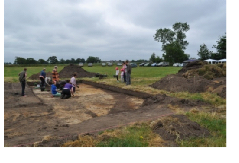
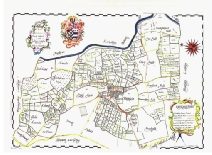
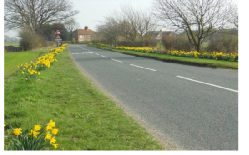
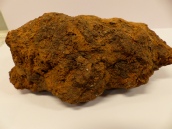
Bog iron
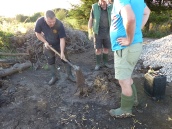
Mixing the clay
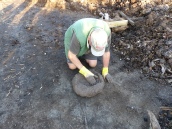
Starting the kiln
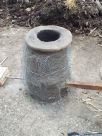
Kiln 3
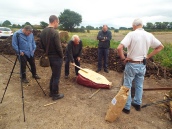
Bellows
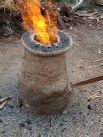
Kiln firing
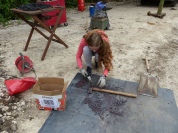
Smashing the iron ore
Fires of hell
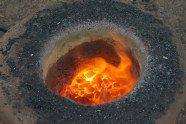
Kiln opened
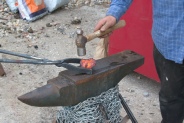

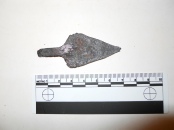
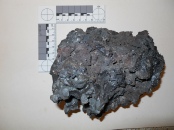
Bloom
Forging 1
Arrow head
IRON SMELTING AND FORGING
Another experiment that I tried, followed from a demonstration that Tony and I visited in Cawthorne Woods some years ago where a kiln was built in situ, fired and iron was smelted replicating what had been archeologically shown to have taken place on this site in the Medieval period.
From moving to North Duffield in 2003 I had constantly been turning up irregularly shaped and heavy lumps of material that was mildly magnetic. More was recovered from the two test pitting events and each of the excavations from 2012 to 2019 and I am still finding when I dig my garden today. Over the years we have wondered why it was that the ‘village’ or settlement we have shown existed from at least the Iron Age and most probably earlier, north east of the village, appeared to have migrated south west to establish Nort Dufelt as it was known in the Doomsday Book. Perhaps there was no such drift, perhaps the original settlement lies beneath modern-
As I was planning and building the application for a second National Lottery Heritage Fund grant of almost £80,000 to spread our investigation of Iron Age settlements in the southern Vale of York, I decided it would be quite fun to experiment with iron smelting since the thrust of our project was the Iron Age. I contacted the archaeologist that had conducted the Cawthorne Woods event and he was enthusiastic and suggested that we went to Sheffield to get a blacksmith to forge a tool or weapon from the ‘bloom’ that we hoped would be the product of the experiment. This really fired (sorry) my imagination but for reasons which I need not go into here, all the plans came to nothing and the event that I had hoped to hold as part of the Festival Archaeology in 2018 did not come to pass.
It needed a chance conversation with a friend in the village to reawaken my interest. My friend had taken a course in black-
So, Ben, my blacksmith friend, and I met to discuss and plan. My original intention was to make a full day of it on the village green and inviting loads of spectators. I got permission in principle from the Parish Council but came up against a brick wall for insurance purposes when we had not got an ‘expert’ smelter. Step forward friendly farmer who offered us a site south of the village to conduct clandestine smelting.
Once more to the Health and Safety and risk assessments and sounding out a small group of volunteers to help and our original date in July 2021 had to be abandoned due to Covid 19 but everything now hinged on a date in September 2021. We still had some clay left from the roundhouse so I filled six bags with this material poured on water and sealed the bags hoping they would sweat and soften the clay. I sourced some sustainable lump-
The site we had been offered by the farmer was a concrete hard-
We planned to start to build the kiln in the evening time on Monday and Tuesday of the week of the smelting. During the daytime I transported all the bags of clay, two bags of straw that I had chopped into small lengths during the days before and two twenty litre plastic containers of water. I also took down about 40 lengths of willow as we had discussed strengthening the structure with them. In the event we decided not to use them.
We all met at the far end away from the footpath on Monday evening knowing that we had two hours of daylight. We opened the bags of clay and broke up the larger lumps which had sweated enough to make them quite soft. We added more water and started treading to mix and break the clay up – what a sticky job! Once the clay was nicely mixed, we added in plenty of chopped straw and started by making a circular base of the mixture Then, very much like the ceramic vessels I had made, we started to roll thick sausage-
The kiln actually took two x 2 hours sessions over successive evenings to build. We then built a screen in front of the kiln to hide it from neerdowells who might walk past on the footpath. I checked the kiln daily to make sure it was safe and not cracking too much. Ben and I returned to the site on Friday and found there had been minimal surface-
On Saturday morning, the day of the smelt we arrived early anxious but excited. We decided to wrap the kiln in chicken wire in case the structure exploded which, in fact, it did not do. Tony had made some bellows from leather and wood.
We started by lighting a fire and gradually building up layers of crushed charcoal, all the while using the bellows to force area into the base of the kiln. This worked extremely well. In the meantime we crushed the bog iron and iron ore pellets. We also broke up the large lumps of charcoal. Now we cheated deliberately by inserting a metal tube into the back of the kiln to allow an electric pump to force air in to the kiln using a generator. My thinking was that we did not know how long we would need to allow the kiln to finish the smelt naturally using the bellows and we could not allow it to take too long as we needed to finish the smelt and forge the bloom before it went dark. As it turned out the bellows were so efficient that we need not have worried.
Once the kiln was full to the brim with burning charcoal we started then to feed in alternate layers of crushed bog and crushed charcoal in the ratio of 1:2 and when the bog iron ran out, crushed iron ore pellets.
We continued this process until we had used up all the iron ore and allowed the kiln to burn out. We achieved a considerable heat and we noticed that cracks started to appear in the outside of the kiln and it was not clear whether it was smoke or steam emanating from these cracks as if it was indeed smoke it would indicate that the fabric of the kiln had cracked through from the inside or if it was steam released from the drying clay.
We found it quite amazing that the wet clay actually stood up to the intense heat. We could see that the inside surface of the kiln had deformed and had become vitrified which became even more apparent when I broke open the kiln. This slide shows the breaking open of the kiln to get at the bloom and this slide shows the formation of the vitrification and deformation of the clay inner surface.
This is a piece of bloom that was created. Here we found that it was likely that the tuyere had been inserted to high up above the base of the kiln: it should have been lower down and pointing more upwards. This had created, we suspect, a cooler area at the base of the kiln where the bloom should have gathered with molten slag which is the impurities created in the firing process. Indeed, there were some pieces of unburnt charcoal in the matrix of slag and bloom supporting that view.
It was now time for the blacksmith to work his magic. Whilst the smelting had been taking place, Ben had been creating a former which would allow him to create iron nails much as those used by the Romans to build their ships and to put as hobnails in the soles of their boots.
He then started to work on the piece of bloom pictured earlier alternatively, heating and hammering the piece. He soon found that the hammering process needed a very gentle touch with a light hammer otherwise the bloom shattered and scattered pieces all over the place rather than consolidating the iron content and shedding the impurities until he finally had a small lump of pure iron. We had succeeded in smelting iron. He then continued to heat and hammer into shape finishing with an iron arrowhead.
What did we show? That many of the processes that prehistoric people used certainly needed either the foresight or pure luck to discover the process in the first place but, once discovered it was relatively easy to replicate it. Did the iron master keep the secrets to himself and pass it down through the family to maintain the mystique and his personal elevation in the hierarchy of the tribe? We will never know but it is more than likely: after all they were humans just like us with the same frailties, ambitions, greed and intelligence. Yes of course it was relatively easy for us to create iron or a roundhouse because we start from a much higher level of knowledge and have access to unlimited resources whilst they were having to invent and fail and try again. But were they so different to the man who invented the jet engine, the atom bomb or the computer? I think not.
Just in passing I should mention that I created leather using a calf skin from an animal that had died on the farm, using oak apples and salt to cure and tan the fabric. Tony made a trebuchet and we were able to hurl rotten cow carcasses into the next village ,(for the serious-
Forging 2